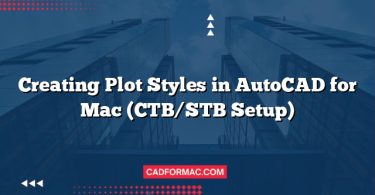AutoCAD for Mac offers a powerful and streamlined environment for design professionals—but to truly maximize efficiency, you need to tailor the interface to your specific workflow. One of the most effective ways to do this is by creating and managing custom workspaces. A well-configured workspace reduces clutter, puts your most-used tools at your fingertips, and ultimately saves you valuable time on every project.
In this guide, we’ll walk you through how to set up, customize, and optimize workspaces in AutoCAD for Mac to boost your productivity.
What Is a Workspace in AutoCAD for Mac?
A workspace in AutoCAD is a saved configuration of the user interface—including toolbars, palettes, ribbon tabs, command line visibility, and more. AutoCAD for Mac comes with a few default workspaces (like “Drafting & Annotation” or “3D Basics”), but these may not align perfectly with your daily tasks.
By creating a custom workspace, you can:
- Show only the tools you use regularly
- Position palettes for optimal screen real estate
- Save time by avoiding constant menu navigation
- Switch instantly between different project types (e.g., 2D drafting vs. 3D modeling)
Step-by-Step: Creating a Custom Workspace
1. Start from a Base Workspace
Open AutoCAD for Mac and choose a default workspace that’s closest to your needs (e.g., “Drafting & Annotation” for 2D work). Go to the Workspace Switching menu in the top-right corner of the application window and select your starting point.
2. Customize Your Interface
Now, tailor the interface to your preferences:
- Show/Hide Palettes: Go to View > Palettes and toggle on only what you need (e.g., Properties, Layers, Blocks).
- Adjust the Ribbon: Right-click any ribbon tab to show or hide specific panels. You can also collapse or expand sections.
- Dock or Float Palettes: Drag palettes to dock them along the edges or keep them floating for quick access.
- Command Line: Toggle the command line with Cmd+9. Position it where it won’t obstruct your drawing area but remains visible.
Pro Tip: Keep your screen uncluttered. Only display tools you use daily—hide the rest to reduce visual noise and improve focus.
3. Save Your Workspace
Once your layout feels right:
- Click the Workspace Switching menu (top-right).
- Choose Save Current As…
- Give your workspace a descriptive name (e.g., “2D Electrical Drafting” or “Architectural Detailing”).
- Click Save.
Your custom workspace is now saved and will appear in the workspace menu for quick access.
Advanced Tips for Speed Optimization
Create Multiple Workspaces for Different Tasks
Don’t try to build a “one-size-fits-all” workspace. Instead, create specialized ones:
- “Quick Sketch”: Minimal interface, only basic draw and modify tools.
- “Layer Management”: Layers palette front and center, with layer filters pre-configured.
- “Plotting Setup”: Page Setup Manager, Plot Preview, and Output tools visible.
Switching between them takes just one click.
Use Keyboard Shortcuts in Conjunction
Custom workspaces pair perfectly with keyboard shortcuts. Assign shortcuts to your most-used commands via AutoCAD > Preferences > User Preferences > Keyboard Shortcuts. This combo—custom UI + hotkeys—dramatically reduces mouse dependency.
Backup Your Workspace Settings
Workspaces are stored in your AutoCAD preferences. To back them up:
- Go to ~/Library/Application Support/Autodesk/AutoCAD 20XX (replace “20XX” with your version).
- Copy the Support folder or the entire AutoCAD 20XX folder.
- Store it securely—this lets you restore your perfect setup after a reinstall or system upgrade.
Sync Across Macs (Optional)
If you work on multiple Macs, manually copy your workspace files to maintain consistency. While AutoCAD for Mac doesn’t offer cloud-synced workspaces like some Windows counterparts, this manual method ensures your optimized environment travels with you.
Troubleshooting Common Issues
- Workspace resets after restart? Ensure you’re saving the workspace after making all UI changes. Also, avoid using “Reset” options unless intentional.
- Missing palettes? Use View > Palettes to restore them, then re-save your workspace.
- Ribbon disappears? Press Cmd+7 to toggle the ribbon on/off.
Frequently Asked Questions (FAQ)
Q: Can I import or export custom workspaces between different Macs?
A: AutoCAD for Mac doesn’t support direct workspace import/export like the Windows version. However, you can manually copy workspace configuration files. Look for your workspace definitions in ~/Library/Application Support/Autodesk/AutoCAD 20XX/RXX.X/enu/Support/ (replace “20XX” and “RXX.X” with your version). Copy the relevant .cui or .cuix files to the same location on another Mac, then restart AutoCAD to see the imported workspace.
Q: Why don’t my custom toolbars appear in my saved workspace?
A: AutoCAD for Mac uses a ribbon-based interface by default and doesn’t support traditional toolbars like the Windows version. If you’re expecting classic toolbars, note that they’re not available on Mac. Instead, customize ribbon panels or use palettes and keyboard shortcuts to replicate that functionality.
Q: Does AutoCAD for Mac support multiple monitor setups with custom workspaces?
A: Yes! AutoCAD for Mac fully supports multiple displays. You can drag palettes (like Properties or Layers) to a secondary screen, and your workspace will remember their positions—as long as the same monitor configuration is active when you reopen the file. If you disconnect a monitor, palettes may snap back to the primary screen.
Q: Can I assign a keyboard shortcut to switch between custom workspaces?
A: Not directly. AutoCAD for Mac doesn’t allow keyboard shortcuts for workspace switching. However, you can use macOS’s built-in Shortcuts app (or third-party tools like Keyboard Maestro) to simulate a click on the workspace menu or create an automation that triggers a specific workspace via AppleScript (advanced users only).
Q: Will updating AutoCAD for Mac delete my custom workspaces?
A: Generally, no. Custom workspaces are stored in your user library and persist through minor updates. However, major version upgrades (e.g., from 2023 to 2024) may reset preferences or require migration. Always back up your Support folder before updating to preserve your workspace configurations.
Q: How do I reset a custom workspace to its original saved state if I accidentally move palettes?
A: Unfortunately, AutoCAD for Mac doesn’t offer a “reload workspace” option that restores the exact saved layout. The safest method is to switch to a different workspace, then switch back—this often resets floating palettes to their last docked or saved positions. For full reliability, keep notes or screenshots of your ideal layout so you can manually restore it if needed.
Final Thoughts
A thoughtfully designed custom workspace isn’t just about aesthetics—it’s a productivity engine. By eliminating unnecessary distractions and placing your essential tools within easy reach, you’ll work faster, make fewer errors, and stay in the creative flow.
Take 15 minutes today to build your first custom workspace in AutoCAD for Mac. Your future self—facing a tight deadline—will thank you.
Remember: The best workspace is the one that you design for your workflow. Don’t be afraid to iterate and refine it as your projects evolve.
AutoCAD for Mac continues to evolve with each release—always explore new interface options to keep your setup lean and lightning-fast.




